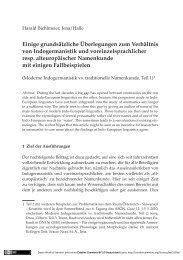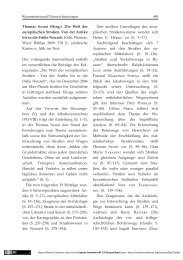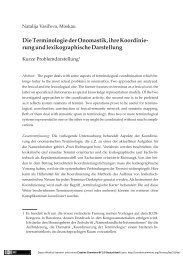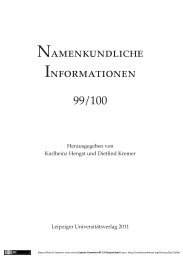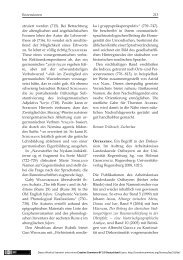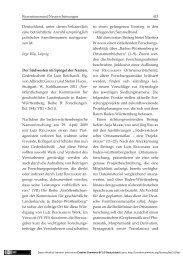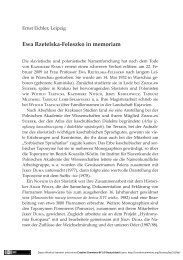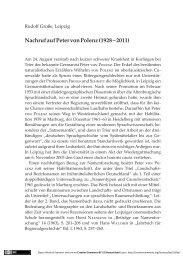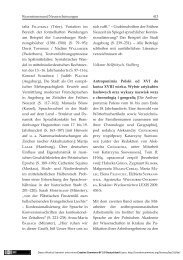Proper Names in the Light of Theoretical Onomastics
Proper Names in the Light of Theoretical Onomastics
Proper Names in the Light of Theoretical Onomastics
Create successful ePaper yourself
Turn your PDF publications into a flip-book with our unique Google optimized e-Paper software.
<strong>Proper</strong> <strong>Names</strong> In <strong>the</strong> <strong>Light</strong> <strong>of</strong> <strong>Theoretical</strong> <strong>Onomastics</strong>97various sectors <strong>of</strong> onomastics and <strong>the</strong> pr<strong>of</strong>essional preparation <strong>of</strong> materialsprovide important knowledge and factual assumptions for formulat<strong>in</strong>ggeneralis<strong>in</strong>g conclusions and syn<strong>the</strong>ses. In <strong>the</strong> process <strong>of</strong> develop<strong>in</strong>g<strong>the</strong> <strong>the</strong>oretical basis and establish<strong>in</strong>g <strong>the</strong> paradigm <strong>of</strong> modern onomastics,it sometimes appears – whe<strong>the</strong>r for l<strong>in</strong>guistic or for o<strong>the</strong>r reasons– as if <strong>the</strong> established <strong>the</strong>ories stand, one next to one ano<strong>the</strong>r, <strong>in</strong> parallel,ra<strong>the</strong>r than <strong>in</strong> mutual <strong>in</strong>ter-relatedness, <strong>in</strong> <strong>the</strong>ir critical development. Theapproach which can be observed <strong>in</strong> l<strong>in</strong>guistics and also <strong>in</strong> ono mastics isalmost symptomatic. A significant pragmatic-communicational shift alsoevident <strong>in</strong> current onomastics is frequently comprehended <strong>in</strong> such a waythat <strong>the</strong>oretical knowledge, which has been achieved to date by “ <strong>the</strong> poststructuralonomastics ” stemm<strong>in</strong>g from its methodology, has not beensuper seded by constructive criticism but, <strong>in</strong> a programmed manner, hasbeen diverted from this knowledge. This note can be detected <strong>in</strong> <strong>the</strong> <strong>in</strong>troductorychapters <strong>of</strong> <strong>the</strong> editors <strong>of</strong> <strong>the</strong> (o<strong>the</strong>rwise representative and valued)proceed<strong>in</strong>gs Namenarten und ihre Erforschung (2004; hereafter NE), and especially<strong>in</strong> S. Brendler’s review <strong>of</strong> <strong>the</strong> monograph by E. Hansack DerName im Sprachsystem. Grundprobleme der Sprach<strong>the</strong>orie (2000). At <strong>the</strong> end <strong>of</strong>this exceptionally positive review, Brendler criticises <strong>the</strong> author for a mislead<strong>in</strong>gtitle to <strong>the</strong> monograph because “a structuralist will not f<strong>in</strong>d <strong>the</strong>rewhat <strong>the</strong> title leads him / her to expect to f<strong>in</strong>d” and “a post-structuralistwill not read it ”. However, <strong>the</strong> proceed<strong>in</strong>gs <strong>of</strong> Namenarten und ihre Erforschungitself provide evidence that such stances are unacceptable. In <strong>the</strong>third part <strong>of</strong> <strong>the</strong> proceed<strong>in</strong>gs, abundant <strong>in</strong>formation and valuable analyses<strong>of</strong> twenty onymic classes are given. Just as sets <strong>of</strong> <strong>in</strong>dividual classes areopen, <strong>the</strong> classes <strong>of</strong> onymic objects <strong>the</strong>mselves are also not closed. Forexample, W. Zel<strong>in</strong>sky (2002) determ<strong>in</strong>ed more than 130 onymic classes;amongst <strong>the</strong>m some classes <strong>of</strong> previously unnoticed objects, such as <strong>the</strong>names <strong>of</strong> prisons, tunnels, parks, playgrounds, cemeteries, gardens, canals,etc. Besides <strong>the</strong> basic nam<strong>in</strong>g groups (bionyms, toponyms, chremat o-nyms), <strong>the</strong> NE proceed<strong>in</strong>gs also pay attention to classes <strong>of</strong> phenomenafor which onymic nom<strong>in</strong>ation does not have clear proprial attributes andfor which <strong>the</strong>ir valuation is not equal (citizen and ethnic names). Thechapter on <strong>the</strong> contribution to methods and methodology, <strong>the</strong> study byP. Videsott on onomatometry as a method <strong>in</strong> onomastics (“ <strong>the</strong> isonomicstructure ” <strong>of</strong> local names <strong>in</strong> similar geographical conditions is analysed <strong>in</strong>deep structure) identify new problems. Unfortunately, <strong>the</strong> proceed<strong>in</strong>gs donot conta<strong>in</strong> a contribution on onomastic lexicography which is extremely



